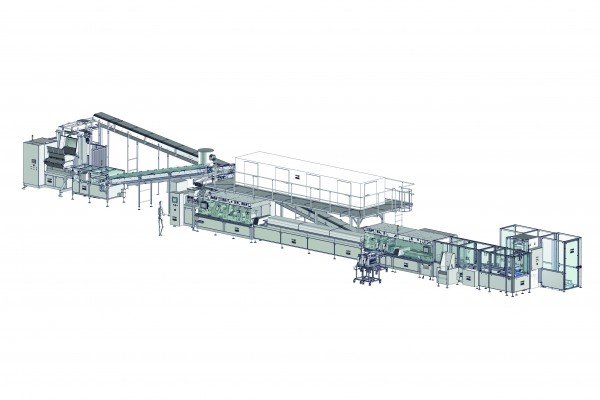Gum processing

Joan Mestres describes what is involved in chewing gum production and how the process has changed.
The production of chewing gum has evolved significantly since the first industrially manufactured gum appeared on the market. However, the basic functions of the manufacturing process are still the same and can be summarised as follows: to mix the ingredients; to give shape to the chewing gum mass; to cool the gum; to cut the gum into individual pieces; and to pack the product.
Each one of these steps differs depending on the type of gum (format) that is being produced and the different engineering developments that have taken place in the machinery that is used in a particular sector.
Mixing
If we consider the first step in the process, when all the ingredients in the gum formulation need to be mixed, there are two main options: batch mixing or continuous mixing. Batch mixing involves using a double sigma or double-z mixer. The blades can have slightly different designs (eg tangential or overlapping) and generally one of them moves at a faster speed than the other.
There should also be a jacket to control the temperature of the vessel because the final mass should not reach more than 55ºC.
Continuous mixing is performed when a large output is required. It is undertaken using a more sophisticated system that requires precise dosing of the ingredients into the mixer-extruder. It is even possible to produce the gum base during the first stages of the mixing process and the chewing gum itself in the same machine. Many patents have been issued that relate to these systems, which are mainly used by the larger manufacturers.
Shaping
Once mass is obtained by using one of the two mixing procedures, it is necessary to shape the gum. This generally involves using an extruder (batch rollers were used in the past). There are a number of different types of extruder including single-screw, double counter-rotating screw and multiple screw versions. This type of equipment will produce a rope (for use when making bubble gum chunks or hollow balls) or a flat sheet (for use when making flat sticks, tabs or coated pillows).
It is advisable to use a pre-extruder to feed the main extruder. The main purpose of this machine is to obtain a constant flow of gum from the main extruder. If the feeding is undertaken manually, there is a greater risk of error because the level of gum inside the hopper can change thereby affecting the output.
An irregular flow of gum will cause problems later. This is especially critical when producing sugar free gum because the formulations used are more sensitive to process parameters.
It is also possible to combine two different masses (colour or flavour) in one single rope. This is done using a co-extruder. A recent trend has been the production of tabs that include a combination of gum and chewy candy. The most common is a piece of gum with a sandwich-like structure – a layer of gum on the top and at the bottom and a layer of chewy candy in the middle.
Cooling and wrapping
The rope of gum passes through a cooling tunnel that is refrigerated to 5–10ºC on a conveyor belt. The ropes coming from the extruder are about 45-50ºC, so a long cooling tunnel is required to ensure they are cool enough to be cut and wrapped. The tunnels are designed with between three and 13 tiers, with one placed above the other in such a way that the rope is fed from the top one and falls onto the one below.
Cooling tunnel designs have changed and developed over time. For example, single layer tunnels where the rope was left to snake while cooling down are becoming less common. The way in which the cold air circulates in the tunnel is important to achieve efficient cooling. It is also important to control the dew point to prevent humidity.
Once cooled, the rope is conveyed to a cut and wrap machine. The evolution of these machines has been spectacular during recent years as they reach greater and greater speeds. The complexity of the machines has resulted in few manufacturers being able to supply top-of-the-range models. Wrapping machines can be combined with other packaging equipment, such as cartoning machines, cellophane wrapping machines and so on.
Another option is for the extruder to produce a hollow rope, which is then transferred to a ball forming machine. As with other formats, the balls need to be cooled to ensure they are hard enough, in this case to be able to withstand the coating process. The cooling process is undertaken using a vibrating table with or without perforations.
The vibration prevents the balls (which are still warm) from standing at a single point and becoming deformed. They are kept moving to maintain their round shape. They are then collected in plastic trays.
The latest developments in this type of line include a uniform/continuous feeding of the forming machine, which is useful to avoid deformation of the rope. Previously, the rope was stopped at the precise moment when it was being cut. As the extruder did not stop, this generated an intermittent flow of rope, which was not ideal.
When the extruder provides a flat continuous sheet/mat of gum, this is processed through a rolling and scoring machine, which consists of pairs of calendar rolls placed one after the other. By controlling the gap and speed between each pair (smaller and smaller), and passing the mat between them, it is possible to achieve a sheet of gum with the required thickness.
The last two pairs of rollers score the gum. The sheets are then collected in trays and taken to a curing room to allow the gum to cool and the ingredients to crystalise. Continuous cooling is also possible. Only then does the sheet become hard and brittle enough to allow the individual pieces to be separated and packed (eg stick gum) or coated (eg gum pillows).
Rolling and scoring
Further developments in rolling and scoring technology include:
• minimising the use of dust – as factories require a cleaner and safer environment, the use of talc, starch and other dusting agents (to prevent the gum from sticking to the rollers) has become a problem, so machinery manufacturers try to reduce the use of those powders
• cooling of the rollers by circulating water inside – cooling of the gum sheet by placing a cooling tunnel between the fourth and fifth pair of calendar rollers. In lines with only four pairs of rollers, this intermediate cooling tunnel is placed between the last roller and the scoring pair. This improves the process by stabilising the mass and reducing its stickiness
• placing another cooling tunnel at the end of the line to harden the sheet and reduce the amount of time that it has to stay in the curing room, if at all
• easy replacement of the scoring rollers so the gum producer can change the format of the product within a shorter time
• the use of metal detectors at different points on the line for various reasons: protection of the rollers from metal particles and safety for the consumer
• the use of a programmable logic controller for the entire line, which enables user-friendly operation and remote control of the machine
• automatic collection and stacking of the trays at the end of the line, which reduces the need for manual labour
• the placement of sensors to detect defective sheets (due to incorrect weight or dimensions), combined with the corresponding device to reject a specific sheet.
All these improvements allow easier and more precise production. In addition, equipment has been adapted in order to comply with higher standards of safety and hygiene.
Coating
The final stage in the production of certain types of gum, such as pillows and balls, is the coating process.
This stage also requires specific equipment in the form of coating pans or drums.
From classical copper pans operated manually, the technology has evolved to consist of complete automatic units that are controlled using a programmable logic controller, which provide good repeatability (recipe control). The main developments in this field have been in spraying systems for syrup (high pressure, without air) and air treatment (temperature and humidity control), both of which help to obtain a smoother surface within a shorter time.
Conclusion
The aim of this article has been to provide an overview of the equipment that is used to produce the most common types of gum. The basic steps in the process are the same, but the machinery that is used is constantly evolving.




How can you control the diameter of the gum if the rope stops at the same time the cutter cuts the ball?